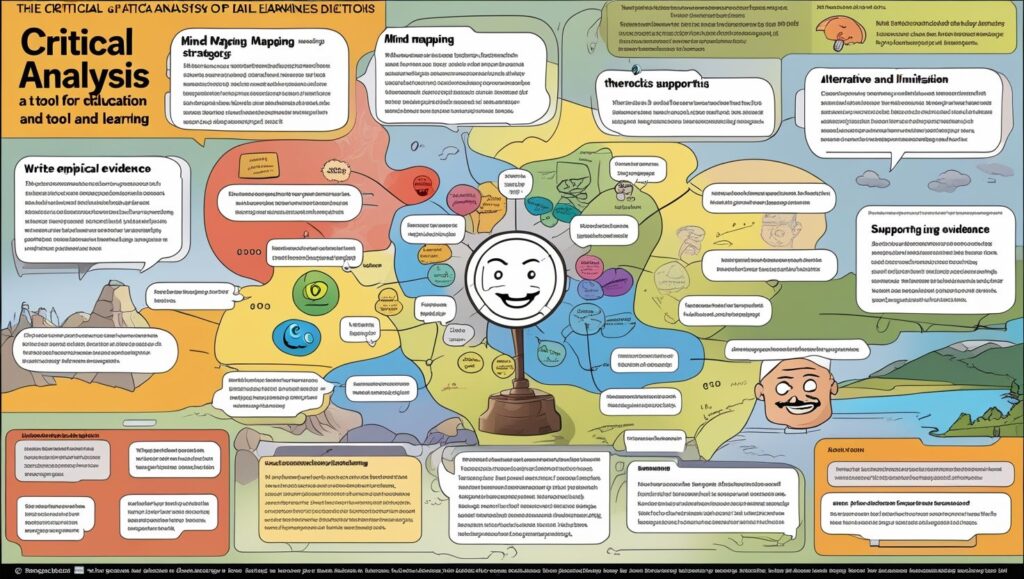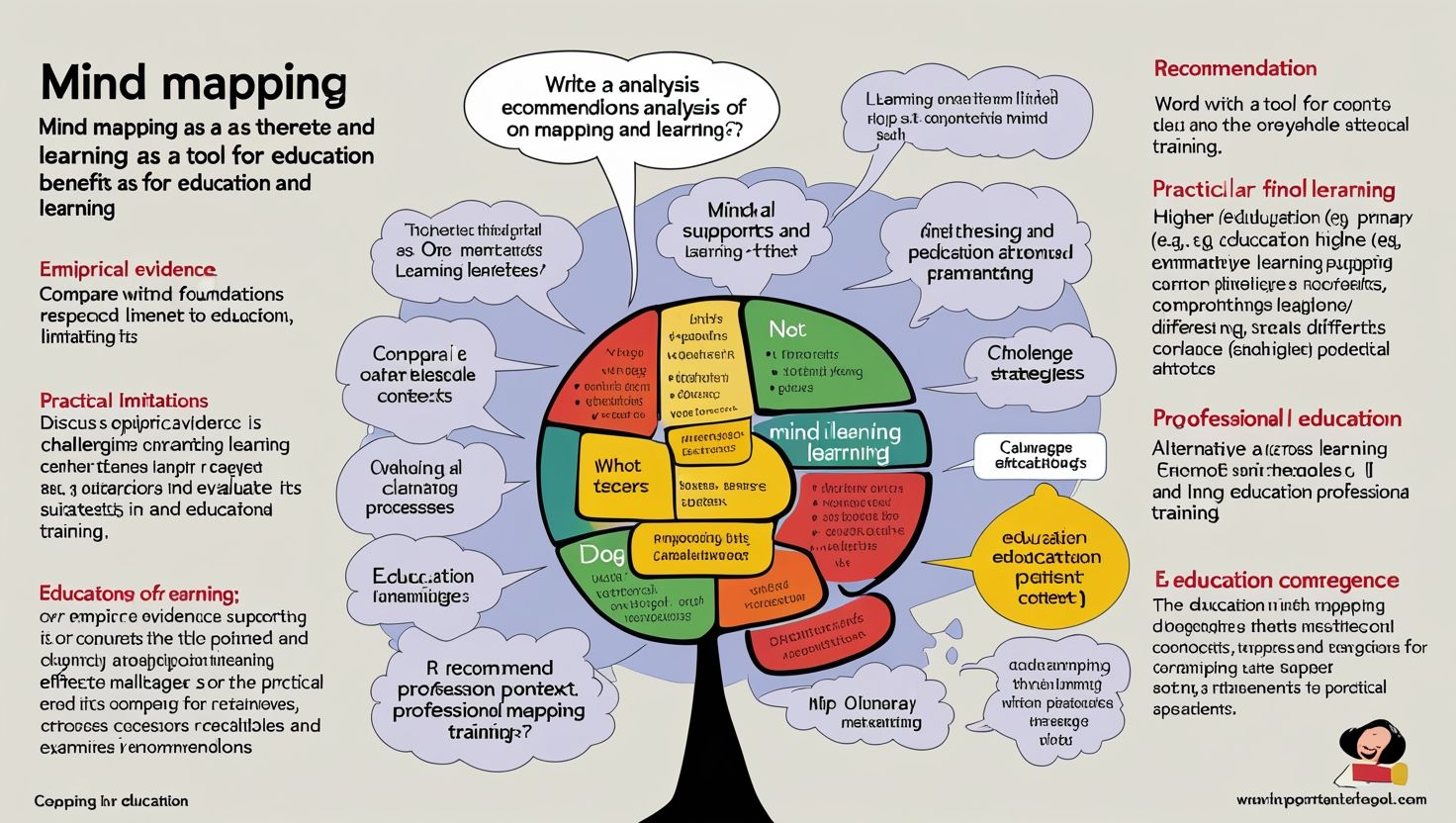Abstract
A Critical Analysis of Mind Mapping for Education and Learning, Mind mapping, a visual thinking tool developed by Tony Buzan in the 1970s, has gained widespread popularity in educational settings as a technique for enhancing learning, memory, and creativity. Proponents argue that it mirrors the brain’s associative thinking processes, making it an effective tool for note-taking, brainstorming, and problem-solving. However, critics question its universal applicability, effectiveness across different learning styles, and empirical validation. This article critically examines mind mapping in education, evaluating its benefits, limitations, and the extent to which it lives up to its claims.
Introduction
Mind mapping is a diagrammatic representation of ideas, with a central concept branching out into related subtopics. It is often promoted as a superior alternative to linear note-taking, fostering creativity, comprehension, and retention. While many educators and students swear by its efficacy, others argue that its benefits are overstated or context-dependent. This article explores the theoretical foundations of mind mapping, its advantages, criticisms, and the empirical evidence supporting (or refuting) its effectiveness in educational settings.
Theoretical Foundations of Mind Mapping
Mind mapping is rooted in several cognitive theories:
- Radiant Thinking (Buzan, 1974): Buzan proposed that the brain processes information non-linearly, making traditional linear notes inefficient. Mind maps, with their radial structure, supposedly align better with natural thought patterns.
- Dual Coding Theory (Paivio, 1971): This theory suggests that combining verbal and visual information enhances memory. Mind maps integrate keywords with images, potentially improving recall.
- Constructivist Learning Theory: Mind mapping encourages active engagement, allowing learners to construct knowledge by connecting new information with prior understanding.
While these theories provide a plausible rationale, their direct application to mind mapping’s effectiveness remains debated.
Advantages of Mind Mapping in Education
1. Enhanced Memory and Recall
Research suggests that visual aids improve retention (Farrand et al., 2002). Mind maps’ use of colors, images, and spatial organization may facilitate better recall than linear notes.
2. Encourages Active Learning
Creating mind maps requires synthesizing information, promoting deeper cognitive processing compared to passive note-taking.
3. Supports Creativity and Problem-Solving
The non-linear nature of mind maps can stimulate creative thinking by allowing free association between ideas.
4. Useful for Complex Subject Matter
Subjects with interconnected concepts (e.g., biology, history) may benefit from mind maps’ ability to show relationships clearly.
5. Accessibility and Flexibility
Mind maps can be adapted for different learners, including those with dyslexia or ADHD, by reducing reliance on dense text.

Criticisms and Limitations of Mind Mapping
Despite its popularity, mind mapping faces several criticisms:
1. Lack of Strong Empirical Evidence
While some studies show positive effects (e.g., D’Antoni et al., 2009), others find no significant advantage over traditional methods (Pressley et al., 1998). Many studies suffer from small sample sizes or lack rigorous controls.
2. Not Universally Effective
Some learners prefer structured, linear formats. Visual thinkers may benefit, but verbal or analytical learners might find mind maps distracting or inefficient.
3. Time-Consuming Creation Process
Constructing detailed mind maps can be labor-intensive, potentially outweighing benefits for time-constrained students.
4. Over-Simplification of Complex Ideas
Mind maps rely on keywords and brief phrases, which may lead to superficial understanding if not supplemented with detailed explanations.
5. Digital vs. Hand-Drawn Debate
Digital tools (e.g., MindMeister, XMind) offer convenience but may lack the cognitive benefits of hand-drawn maps, which involve deeper motor and spatial engagement.
Mind Mapping in Different Educational Contexts
1. Primary and Secondary Education
Younger students may benefit from mind maps’ visual appeal, but excessive reliance could hinder development of structured writing skills.
2. Higher Education and Research
In complex academic writing, mind maps may help organize ideas but are rarely sufficient for in-depth analysis.
3. Corporate and Professional Training
Used in brainstorming and project planning, but effectiveness depends on the team’s familiarity with the technique.
Alternative Approaches
Other visual tools, such as concept maps (more hierarchical and detailed) or flowcharts, may be better suited for certain tasks. Traditional outlining remains effective for linear thinkers.
Conclusion
Mind mapping is a valuable but not universally superior learning tool. Its effectiveness depends on individual preferences, subject matter, and implementation. While it enhances creativity and memory for some, others may find it cumbersome or less efficient than conventional methods. Educators should consider integrating mind mapping as one of several strategies rather than a one-size-fits-all solution. Further rigorous research is needed to clarify its optimal use cases and limitations.
References
- Buzan, T. (1974). Use Your Head. BBC Books.
- Farrand, P., Hussain, F., & Hennessy, E. (2002). “The efficacy of the mind map study technique.” Medical Education, 36(5), 426-431.
- D’Antoni, A. V., et al. (2009). “Does the mind map learning strategy facilitate information retrieval and critical thinking in medical students?” BMC Medical Education, 9(1), 61.
- Pressley, M., et al. (1998). “The challenges of classroom strategy instruction.” Educational Psychologist, 33(1), 1-13.

11 thoughts on “A Critical Analysis of Mind Mapping for Education and Learning”
Comments are closed.